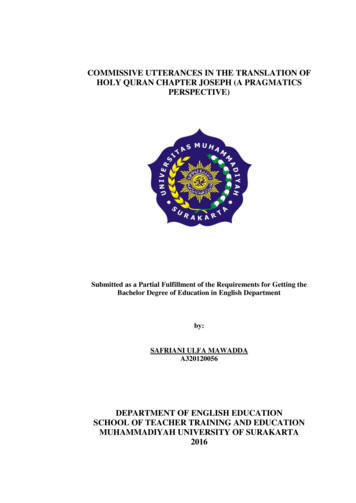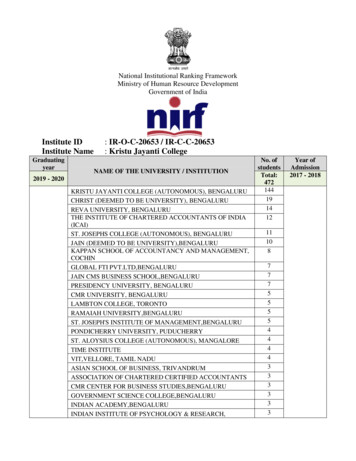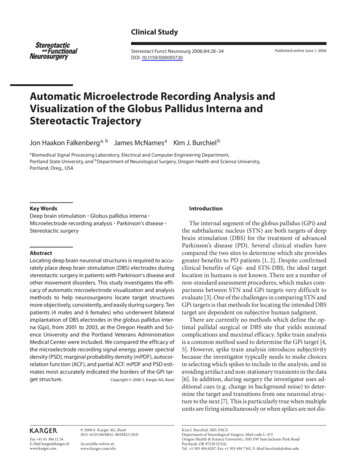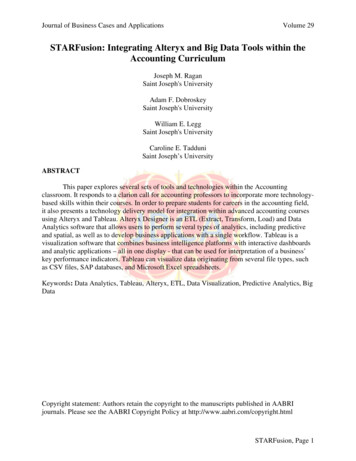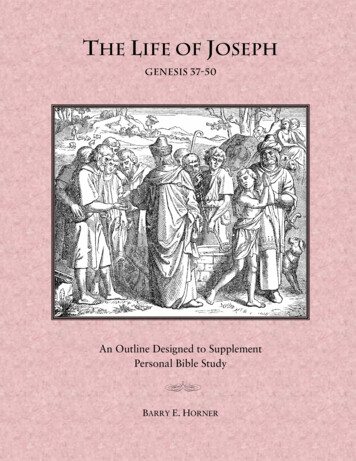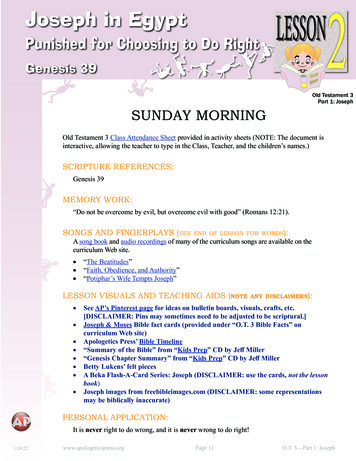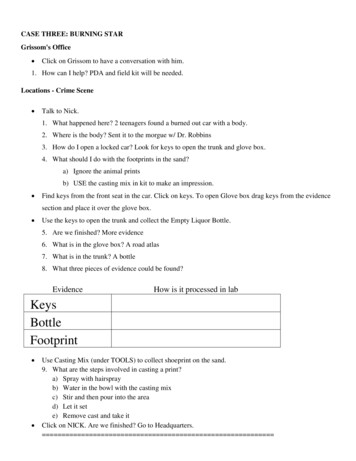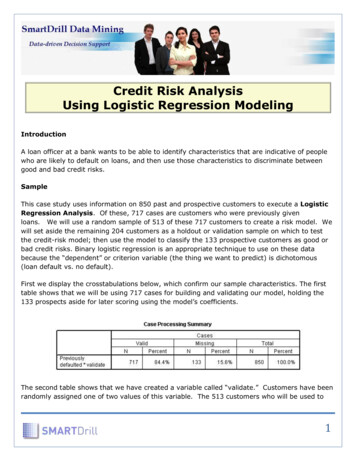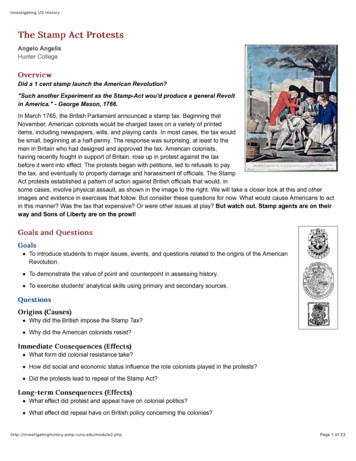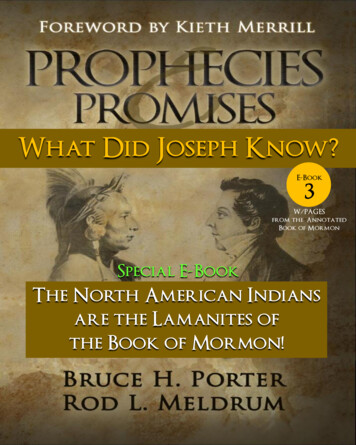
Transcription
What Did Joseph Know?E-Book3W/PAGESfrom the AnnotatedBook of MormonSpecial E-BookThe North American Indiansare the Lamanites ofthe Book of Mormon!
Dedicated to the late Dr. Robert J. Matthewswho, after reading this manuscript,said with a twinkle in his eye—“I am a one-hill man. I’ve always been a one-hill man justlike the Prophet Joseph Smith was, and if I’m wrong well, atleast I’m in good company!”
2009 Bruce H. Porter and Rod L. MeldrumAll rights reserved. No part of this book may bereproduced in any form or by any means withoutpermission in writing from the publisher, Digital Legend Press.For additional copies visit: www.latterdaylegends.comSend inquiries to:Digital Legend Press and Publishing1994 Forest Bend Dr.Salt Lake City, UT 84121U.S.A.To see all of Digital Legend’s titles visitwww.digitalegend.com/catalogFor info write to: info@digitalegend.comor call toll free: 877-222-1960Printed in the United States of AmericaFirst Printing: Oct 2009 (V5)ISBN: 978-1-934537-34-3
Annotated Edition of the Book of Mormon by David Hocking and Rod Meldrum Page xxvi
Prophecies and PromisesBy Bruce C. Porter and Rodney L. Meldrum E-Book 3What Did Joseph Know?What the Prophet Joseph Smith knew of the geography of the Book of Mormon can be learned from hisstatements that are recorded in journals and accounts prepared and published by him and later by the Churchas well as a study of his actions in these regards. These published accounts give substantial clues to hisknowledge on this matter. There are two key concepts that need to be understood pertaining to the statementsof Joseph Smith, particularly regarding the extensive amount of geographical discussion that has taken placeover the years by Mesoamerican theorists. Their concepts are one, Joseph simply didn’t know, was unaware,or was speculating about the geography of the Book of Mormon early in his prophetic calling; and two, henever claimed inspiration on the matter of geography.This book is dedicated to the historically documented fact that the Prophet Joseph Smith did, in fact, knowabout the geographical setting for the Book of Mormon and that he did, in fact, claim inspiration for thestatements he made about its geography. Joseph Smith’s published accounts and his claim of revelation on thematter of geography mentioned in the following chapters of this book will stand on their own, as authoritativestatements from a prophet of God. This chapter is not meant to be an exhaustive study of the Prophet’sstatements that might outline arguments for or against any one geographical theory. Nor is it intended todebate the implied meaning or authorship of the accounts reviewed. Such an in-depth review of thesearguments is reserved for a separate text that will follow in due time.The “authority” of scripture—prophet, person or law—in an individual’s life is completely dependent on theperson’s acceptance or rejection of that authority. The Standard Works have no authority or power in anyone’slife unless that person allows scripture that authority. Nor do the words of a prophet—modern or ancient—have any specific authority in someone’s life unless they decide to accept the prophet and his words asauthoritative. If individuals consider their education, knowledge, or beliefs more authoritative and correctthan scripture or revealed prophetic statements, they are placing their trust in the arm of flesh. The decisionmust be made by the individual to accept or reject the statements of Joseph Smith as inspired. Often trainingand tradition will condition and influence an individual in his acceptance of an “authority” in his life. That isan individual decision and choice.“This Continent”The prior discussion about the demonstrative “this” must be kept in mind as a word that is used to indicatethe defined noun within proximity of the speaker. First, look at the words of Moroni as described by JosephSmith and found in the canonized scriptures. The Prophet Joseph writes that Moroni appeared and taught himabout a book “written upon gold plates.” Joseph was told by this angelic messenger sent from God, that thisrecord gave an account of the “former inhabitants of this continent” (Joseph Smith-History 1:34).The interpretation of the phrase “former inhabitants of this continent” must, for clarity of understanding, haveone of two meanings or conclusions. Either this refers to “this continent” or it does not. If it does not refer tothe United States, a person would have to ignore the demonstrative “this” and then redefine “this continent”into a generality of hemisphere or continent(s). To assume the latter would mean that either Joseph or Moronimade a mistake in the description and the use of the demonstrative in pointing to the “which” continent. Theinspired text should be able to be understood as correctly in 1830 as well as 2030 by reading the words1chosen by the Lord.
Land of CainanNew JerusalemLand of CanaanJerusalemThe interpretation of the phrase “former inhabitants of this continent” must, for clarity of understanding, haveone of two meanings or conclusions. Either this refers to “this continent” or it does not. If it does not refer tothe United States, a person would have to ignore the demonstrative “this” and then redefine “this continent”into a generality of hemisphere or continent(s). To assume the latter would mean that either Joseph or Moronimade a mistake in the description and the use of the demonstrative in pointing to the “which” continent. Theinspired text should be able to be understood as correctly in 1830 as well as 2030 by reading the wordschosen by the Lord.Even though in the early 1800s the American continent was defined by Noah Webster’s dictionary to be all ofNorth and South America, later refinements divide North America from South America as two distinct andseparate continents. If a North American geographic setting is applied, then Joseph’s statement remains trueboth then and now, but if a South American setting is used, then Joseph’s statement was true only during histime, and is no longer true because Joseph was never on the South American continent. The Lord knew whatthe best definition of “this land” and “this continent” would be and inspired Joseph Smith accordingly. The2statements are as correct then as they are now.
Lucy Mack SmithThe earliest account of the life of Joseph Smith and the events that surrounded the Smith family during theprophet’s youth is recorded by his mother. Lucy Mack Smith, the mother of Joseph Smith, described thefamily gatherings as young Joseph rehearsed those thing that he had learned from the Lord and the messengerssent to teach him of this great work. Remember that this is in the time frame between the “First Vision” andthe retrieval of the plates by Joseph from the Hill Cumorah."From this time forth, Joseph continued to receive instructions from the Lord, and we continued to get thechildren together every evening for the purpose of listening while he gave us a relation of the same. I presumeour family presented an aspect as singular as any that ever lived upon the face of the earth—all seated in acircle, father, mother, sons and daughters, and giving the most profound attention to a boy, eighteen years ofage, who had never read the Bible through in his life: he seemed much less inclined to the perusal of booksthan any of the rest of our children, but far more given to meditation and deep study.During our evening conversations, Joseph would occasionally give us some of the most amusing recitals thatcould be imagined. He would describe the ancient inhabitants of this continent, their dress, mode of traveling,and the animals upon which they rode; their cities, their buildings, with every particular; their mode ofwarfare; and also their religious worship. This he would do with as much ease, seemingly, as if he had spenthis whole life among them.52 Lucy Mack Smith “This was before he received the plates. He must havereceived this by revelation, for he knew the whole story of the content of the record that is now the Bookof Mormon. He had had five long visits with Moroni, and his mother says he received many revelations.”Eldred G. Smith, Conference Report, October 1967, pp. 82-84This description of the first family home evenings in this dispensation gives insight into his revelations andlearning as Joseph Smith’s mother states that he “continued to receive instructions from the Lord.” Shedescribes that his insights and inspiration were as though “he had spent his whole life among” those who werethe “ancient inhabitants of this continent.” Again the records are clear as to the inspiration Joseph received,that he knew the land were these things happened. Joseph’s knowledge and understanding of this culture wasbroad and comprehensive, according to his mother.There is not another person, anthropologist or archaeologist, then or now, who would know more about thedetails of the day to day life of the Nephite and Lamanite cultures, than Joseph Smith. Joseph is the onlyprophet who has, in confidence declared, where places and events took place that were recorded in the Book ofMormon.McGavin and Bean explain their point of view concerning the identity of theHill Cumorah as an ancient battlefield. The authors conclude that the scholars"need not search for [Cumorah] in Mexico or Yucatan" E. Cecil McGavin andWillard W. Bean "Cumorah-Land, An Ancient Battlefield," in The ImprovementEra 44, September 1941, 526, 571-72.3
4Annotated Edition of the Book of Mormon by David Hocking and Rod Meldrum Page 431
Mission to the LamanitesAs described in the Title Page of the Book of Mormon written by Moroni, this record is to be taken to the“remnant” of the seed of Lehi, to convince them that Jesus is the Christ. Almost as soon as the church wasorganized, the Lord instructs Oliver Cowdery, through Joseph, that this gospel is to be taken to the Lamanites. TheLord through the Prophet Joseph instructs Oliver Cowdery to “go unto the Lamanites” and that he will receiverevelations about this important mission to the Lamanites but that he is not to write them down as part of the latterday commandments. It would appear from the references below that the Lord knows where the Lamanites arelocated and also that they are a “remnant” of Lehi that remain upon the land."And now, behold, I say unto you that you shall go unto the Lamanites and preach my gospel unto them; andinasmuch as they receive thy teachings thou shalt cause my church to be established among them; and thou shalthave revelations, but write them not by way of commandment." D&C 28:8The Lord later instructs these brethren that the city of Zion shall be built on the border by the Lamanites. And thatthey are to take their journey among the Lamanites."And now, behold, I say unto you that it is not revealed, and no man knoweth where the city Zion shall be built,but it shall be given hereafter. Behold, I say unto you that it shall be on the borders by the Lamanites."And thou shalt assist to settle all these things, according to the covenants of the church, before thou shalt take thyjourney among the Lamanites." D&C 28:9, 14In the same month the Lord instructs Peter Whitmer and Oliver Cowdery to be the first missionaries to take thegospel and words of the record to the Lamanites as declared by Christ in Third Nephi. The exact location of thismission is given by instruction a revelation from the Lord a short time later."Behold, I say unto you, Peter, that you shall take your journey with your brother Oliver; for the time has comethat it is expedient in me that you shall open your mouth to declare my gospel; therefore, fear not, but give heedunto the words and advice of your brother, which he shall give you.""And be you afflicted in all his afflictions, ever lifting up your heart unto me in prayer and faith, for his and yourdeliverance; for I have given unto him power to build up my church among the Lamanites;" D&C 30:5-6In October of 1830 two more missionaries are called to assist in the teaching of the Lamanites. This firstmissionary force will now have the addition of Parley P. Pratt, Ziba Peterson, and the Lord as they go among theLamanite remnant to teach."And now concerning my servant Parley P. Pratt, behold, I say unto him that as I live I will that he shall declaremy gospel and learn of me, and be meek and lowly of heart."And that which I have appointed unto him is that he shall go with my servants, Oliver Cowdery and PeterWhitmer, Jun., into the wilderness among the Lamanites.""And Ziba Peterson also shall go with them; and I myself will go with them and be in their midst; and I am theiradvocate with the Father, and nothing shall prevail against them.""And they shall give heed to that which is written and pretend to no other revelation; and they shall pray always5that I may unfold the same to their understanding." D&C 32:1-4
Annotated Edition of the Book of Mormon by David Hocking and Rod Meldrum Page 1166
The four missionaries—Parley P. Pratt, Oliver Cowdery, Peter Whitmer, Jr., and Ziba Peterson—left immediately upon theLord’s instruction and commenced the very first mission of the church west of New York. The History of the Churchdescribes the events of this Lamanite mission in these words:"Immediately on receiving this revelation, preparations were made for the journey of the brethren therein designated, to theborders of the Lamanites, and a copy of the revelation was given them. They bade adieu to their brethren and friends, andcommenced their journey, preaching by the way, and leaving a sealing testimony behind them, lifting up their voice like atrump in the different villages through which they passed. They continued their journey until they came to Kirtland, Ohio,where they tarried some time, there being quite a number in that place and vicinity who believed their testimony and cameforward and obeyed the Gospel. Among the number was Mr. Sidney Rigdon, and a large portion of the church over which hepresided." 53The Mission to the Lamanites as declared and described by the Lord in the Doctrine and Covenants clearly reflects that Josephsent the missionaries to the areas revealed and directed by the Lord. The scriptures imply that not only were they to preach tothe Native Americans on this North American continent, but that they are a remnant of the seed of Lehi and “Lamanites” asdescribed in the Book of Mormon and Doctrine and Covenants. 54Parley P. Pratt also speaks of this first mission to the Lamanites in these words as he describes and names the NativeAmerican tribes to whom he was sent to preach the gospel."Thus ended our first Indian Mission, in which we had preached the gospel in its fulness and distributed the record of theirforefathers among three tribes, viz: the Catteraugus Indians, near Buffalo, N.Y., the Wyandots of Ohio, and the Delawareswest of Missouri. We trust that at some future day, when the servants of God go forth in power to the remnant of Joseph,some precious seed will be found growing in their hearts, which was sown by us in that early day." 55Elder Pratt walked about “fifteen hundred miles” and preached the “gospel to tens of thousands of Gentiles and two nations ofIndians.”56 It must be realized and accepted that the Lord knew, and therefore Joseph knew, where the Lamanites werelocated and that a remnant was left in fulfillment of the Prophecies and Promises that are revealed in the Book of Mormon.These first missionaries to the Lamanites were sent to where the Lord commanded and meant them to go. There is noindication in Church History of dissatisfaction by the Lord in their mission, nor is there any reason to think that they did notpreach to the “Lamanites” as directed by the Lord, who indicated that He would go with them and be in their midst.Following the loss of the 116 pages of manuscript, when the Lord requested something from Joseph, the Prophet beganimmediately to try to accomplish it. This mission to the Lamanites is an example of Joseph’s dedication to the requirementsestablished by the Lord. It was 117 years later that the gospel was taken to Guatemala. The promises of the Savior atBountiful to those who gathered there emphatically stated that when the Gentiles received “these things” [the Book ofMormon] they would then be taken to the Lamanite remnant. This objective was a major concern of Joseph Smith until hisdeath according to church historian Ronald W. Walker in his article Seeking the Remnant; the Native American in the JosephSmith Period. He writes:"RECENT SCHOLARS HAVE largely set aside the Native American as an important force in early Restoration history,1830-44. After telling the familiar story of Oliver Cowdery's 1830-31 Lamanite mission, most writers either grow quiet on thetopic or say that Joseph Smith and other Mormon leaders became preoccupied with more pressing things. But the evidencesupports another view. First-generation leaders, while not always having the freedom to interact with the Indian as theywished, consistently sought the Native American "remnant" of Jacob. This argument, more than revising a familiar historicaltenet, provides a window through which to view early Mormonism. It shows the millennial spirit of the movement's firstyears, helps to explain the intensity of early anti-Mormonism, and reveals one of the reasons why the Mormon hegira took thepath it did. Finally, it suggests that the Book of Mormon, which lay at the heart of the original disciples' view of the Indian,was more than a theoretical handbook. It actually affected how Mormons thought and what they did.There is no mistaking the importance of the Indian during the earliest part of Joseph Smith's ministry. His first and greatestrevelation was the Book of Mormon, which was not just a record of the "Lamanite" or Native American people, but a highlyunusual manifesto of their destiny.” 577
8Annotated Edition of the Book of Mormon by David Hocking and Rod Meldrum Page 526
The Wentworth LetterIn 1841, at the request of John Wentworth, Joseph Smith wrote a letter describing the rise of the Church of JesusChrist of Latter-day Saints and a proclamation of the basic beliefs that distinguish the Church from otherreligions. It is from this inspired letter that the 13 Articles of Faith are gleaned that so many Latter-day Saintshave memorized as children. The Wentworth Letter was written in Joseph’s own words and signed by himpersonally. The following statement clearly relates “this country” [that is where Joseph is at] to “this continent”and the inhabitants and Prophets that lived there. It is important to note that the statements of Joseph containedin this letter boldly testify of his inspiration and the revelations on matters pertaining not only to the record andthe history of the people, but also the land where it took place."On the evening [of] the 21st of September, a.d. 1823, while I was praying unto God and endeavoring toexercise faith in the precious promises of scripture, on a sudden a light like that of day, only of a far purer andmore glorious appearance and brightness, burst into the room. Indeed the first sight was as though the house wasfilled with consuming fire. The appearance produced a shock that affected the whole body. In a moment apersonage stood before me, surrounded with a glory yet greater than that with which I was already surrounded.This messenger proclaimed himself to be an angel of God, sent to bring the joyful tidings that the covenantwhich God made with ancient Israel was at hand to be fulfilled; that the preparatory work for the second comingof the Messiah was speedily to commence; that the time was at hand for the gospel in all its fulness to bepreached in power unto all nations, that a people might be prepared for the millennial reign. I was informed thatI was chosen to be an instrument in the hands of God to bring about some of His purposes in this gloriousdispensation.I was also informed concerning the aboriginal inhabitants of this country [America] and shown who they were,and from whence they came; a brief sketch of their origin, progress, civilization, laws, governments, of theirrighteousness and iniquity, and the blessings of God being finally withdrawn from them as a people, was [also]made known unto me; I was also told where were deposited some plates on which were engraven an abridgmentof the records of the ancient prophets that had existed on this continent. The angel appeared to me three timesthe same night and unfolded the same things. After having received many visits from the angels of God,unfolding the majesty and glory of the events that should transpire in the last days, on the morning of the 22ndof September, a.d. 1827, the angel of the Lord delivered the records into my hands.*In this important and interesting book the history of ancient America is unfolded, from its first settlement by acolony that came from the Tower of Babel at the confusion of languages to the beginning of the fifth century ofthe Christian era. We are informed by these records that America in ancient times has been inhabited by twodistinct races of people. The first were called Jaredites and came directly from the Tower of Babel. The secondrace came directly from the city of Jerusalem about six hundred years before Christ. They were principallyIsraelites of the descendants of Joseph. The Jaredites were destroyed about the time that the Israelites camefrom Jerusalem, who succeeded them in the inheritance of the country. The principal nation of the second racefell in battle towards the close of the fourth century. The remnant are the Indians that now inhabit this country.This book also tells us that our Savior made His appearance upon this continent after His Resurrection; that Heplanted the gospel here in all its fulness, and richness, and power, and blessing; that they had apostles, prophets,pastors, teachers, and evangelists—the same order, the same priesthood, the same ordinances, gifts, powers, andblessings, as were enjoyed on the eastern continent; that the people were cut off in consequence of theirtransgressions; that the last of their prophets who existed among them was commanded to write an abridgmentof their prophecies, history, etc., and to hide it up in the earth; and that it should come forth and be united withthe Bible for the accomplishment of the purposes of God in the last days.9*Red Color areas omitted from Teachings of Presidents of the Church: Joseph Smith 2011
10Annotated Edition of the Book of Mormon by David Hocking and Rod Meldrum Page 551
For a more particular account I would refer to the Book of Mormon, which can be purchased at Nauvoo, orfrom any of our traveling elders." 58It is common knowledge that when Joseph prepared something for publication, he was overtly concernedabout being so correct in his choice of words that there could be no misunderstanding in the intended meaningby the reader. This is a prophetic responsibility to make sure there would be no mistake in comprehensionwhich might lead to false information or doctrine. The Prophet reveals in the above quote that the remnants ofthe people in the Book of Mormon are the “Indians that now inhabit this country,” [not all natives in thewestern hemisphere]. The Prophet Joseph then continues with the statement that “This book also tells us thatour Savior made His appearance upon this continent after His resurrection; that He planted the Gospelhere.”59Joseph used again the demonstrative that is singular and points to “which” country and “which” continent andcorrectly pronounces “this continent” which is where he stands when making the statement. He states that theSavior appeared on “this continent” as recorded in the Book of Mormon. This should clearly indicate that thecontinent of South America is not included. Central or Mesoamerica is considered to be a part of the NorthAmerican continent, but not a part of Joseph’s “this country” which unmistakably refers to the area and“country” in which he lived.Joseph Smith knew and was shown, as he testifies, who exactly the Book of Mormon people were, where theycame from, their origins, how they and their civilization progressed. He also knew them so intimately as tounderstand their very laws and governmental system, as he recorded in the Wentworth Letter and as recordedby his mother. In the summer of 1828, following the loss of the 116 pages of the Book of Mormon manuscript,the Lord speaks to the Prophet Joseph about the Nephite record, the land and nations that will be upon “thisland.” These statements directed to Joseph Smith from the Lord do not imply a land other than where Joseph isreceiving the revelation. To try to stretch the meaning of “this land” in this revelation to include Central orSouth America is beyond comprehension. This revelation is directly from the Lord to Joseph Smith and aboutthe Gospel and the land where Joseph received the revelation. The verses below become important inunderstanding the location of “this people” and “this land” that will be free unto all, because this passage isnot from the Book of Mormon and cannot be construed to have a hemispherical setting."And, behold, all the remainder of this work does contain all those parts of my gospel which my holyprophets, yea, and also my disciples, desired in their prayers should come forth unto this people. And I saidunto them, that it should be granted unto them according to their faith in their prayers; Yea, and this was theirfaith—that my gospel, which I gave unto them that they might preach in their days, might come unto theirbrethren the Lamanites, and also all that had become Lamanites because of their dissensions.Now, this is not all—their faith in their prayers was that this gospel should be made known also, if it werepossible that other nations should possess this land;And thus they did leave a blessing upon this land in their prayers, that whosoever should believe in this gospelin this land might have eternal life; Yea, that it might be free unto all of whatsoever nation, kindred, tongue, orpeople they may be." D&C 10:46-51The United States is the promised land foretold in the Book of Mormon—a place wheredivine guidance directed inspired men to create the conditions necessary for the Restoration11of the gospel of Jesus Christ.” Elder L. Tom Perry Ensign Dec. 2012
Annotated Edition of the Book of Mormon by David Hocking and Rod Meldrum Page 41512
Without doubt it is intended by the Lord that “this land” meant “this land” as it would be a land “free unto all ofwhatsoever nation or people they may be.” This is a discussion between the Prophet Joseph and the Lord, not apassing reference in the Book of Mormon of “a land” or “the land” meant to be general and inclusive of theentire western hemisphere. “This land” in this context and in this discussion with Joseph Smith would mean thevery land upon which Joseph Smith stands and declares that the land of the Nephites and the land where Josephreceives this revelation are one and the same.Current thought and consensus of scholarly opinion on Book of Mormon geography nearly demands a belief in aMesoamerican setting for the Book of Mormon. If the realities were so distant and general the Lord would nothave been so specific to Joseph about “this land.”A common explanation offered by Mesoamerican theorists is that all of the statements by Joseph Smith includethe entire western hemisphere. However, this premise cannot be construed from the documented statements andpersonal letters of the Prophet Joseph. The Prophet is clear and concise in his statements about Book of Mormongeography, yet the allure and enticement of Mesoamerican ruins and a desire for physical proof seems todetermine the interpretation and interpolation of the words of the Prophet Joseph Smith. It is regrettable that somany cannot simply take Joseph Smith at his word.The American Revivalist AccountJoseph Smith sent the following letter to N. C. Saxton, the editor of a Rochester, New York newspaper written, asJoseph Smith later indicated, "by the commandment of God." Kirtland 4th Jan. 1833—"Mr. Editor Sir,Considering the Liberal principles upon which your interesting and valuable paper is published and myself beinga subscriber and feeling a deep interest in the cause of Zion and in the happiness of my brethren of mankind Icheerfully take up my pen to contribute my mite at this every [very] interesting and important period.The Book of Mormon is a record of the forefathers of our western Tribes of Indians, having been found throughthe ministration of an holy Angel translated into our own Language by the gift and power of God, after havingbeen hid up in the earth for the last fourteen hundred years containing the word of God, which was deliveredunto them, By it we learn that our western tribes of Indians are descendants from that Joseph that was sold intoEgypt, and that the land of America is a promised land unto them, and unto it all the tribes of Israel will come.with as many of the gentiles as shall comply with the requisitions of the new co[v]enant. But the tribe of Judahwill return to old Jerusalem. The City of Zion, spoken of by David in the 102 Psalm will be built upon the Landof America and the ransomed of the Lord shall return and come to it with songs and everlasting joy upon theirheads, and then they will be delivered from the overflowing scourge that shall pass through the Land But Judahshall obtain deliverance at Jerusalem see Joel 2:32. Isaiah 26, 20 & 21, Jer. 31:12, Psalm 50:5, Ezekiel 34, 11, 12& 13.“(Signed)Joseph Smith Jr. 60“I do not believe that there were two Hill Cumorahs, one in Central America and the otherone up in New York, for the convenience of the Prophet Joseph Smith, so that the poor boywould not have to walk clear to Central America to get the gold plates.” Elder Mark E.13Petersen, General Conference Address, April 1953
14Annotated Edition of the Book of M
The prior discussion about the demonstrative "this" must be kept in mind as a word that is used to indicate the defined noun within proximity of the speaker. First, look at the words of Moroni as described by Joseph Smith and found in the canonized scriptures. The Prophet Joseph writes that Moroni appeared and taught him
